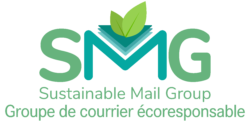Paper
“The Sustainable Mail Group advocates for a shift towards 100% sustainable paper consumption and distribution.” To learn why, read on….
Paper Consumption and Sourcing
PAPER CONSUMPTION, SOURCING and RECYLABILITY
Overview
The mailing industry, supported by the Sustainable Mail Group (SMG), creates and distributes a huge number of marketing and public service pieces that are the foundation on which we create tangible communication materials.
Most of these pieces are made of paper, sourced from one of the most renewable resources on the planet—wood—and is strictly regulated by Natural Resources Canada (NRC). That agency’s mandate is designed not only to promote zero waste but to emphasize total use of the tree and beneficial reuse of paper manufacturing by-products. NRC’s regulations have been remarkably successful. Over the past ten years, the tree canopy in Canada has been reduced by less than .02%, making Canadian forests amongst the most sustainable on the planet.
When sourced responsibly from forestlands managed under best forestry practices and using the entire tree until fully consumed, paper enhances the sustainability of the mail value chain.
Let’s start with trees. They are harvested and the tree’s trunk is used for multiple products, mainly timber for home building, stairs, doors, furniture, cabinets, flooring and pallets. The branches and residue remaining from the products mentioned above, like wood chips and sawdust, are used for the production of pulp and paper, until the tree has been fully consumed.
Paper Consumption and Sourcing Objective
The Sustainable Mail Group advocates a shift towards 100% sustainable paper consumption and distribution. SMG recommends that marketers and mail service providers recommend responsibly sourced paper to their mailing customers.
First steps
- Favour the responsible use of paper in our mailing pieces and educate consumers on the use of the most renewable resource in the world—wood fiber from trees—as the foundational material of sustainable mail:
- Paper and pulp produced from tree residue and the beneficial reuse of manufacturing by-products from their production, contribute to a circular economy. The list of beneficial reuse of paper production by-products include carbon-neutral bio-mass fuels to generate power, ash and causticizing residuals for silvicultural regeneration and a custom blend of boiler ash, wastewater treatment residuals and causticizing residuals to create an agricultural fertilizer for growing crops, just to name a few.
- Purchase paper that has been certified by recognized independent, third-party certifying bodies like:
- Forestry Stewardship Council (FSC)
- Programme for the Endorsement of Forest Certification (PEFC)
- Sustainable Forestry Initiative (SFI)
As for recyclability, a single piece of paper can be recycled and processed through the value chain up to six times before its fibers are too depleted to hold together. At that point, it can be used for alternative products like tissue paper.
